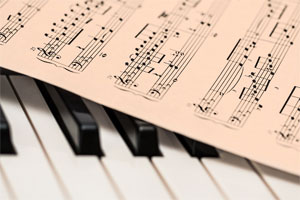National Anthem History
Crafting a concise history of how the United States' National Anthem came to be is a bit of a daunting task. The U.S. national anthem is as old as the nation itself, and describing its origins goes hand in hand with the origins of America.
Today, the U.S. is a vast nation with roughly about 300 million people, a nation existing at a time of mass information, globalisation and a huge political divide. But what remains true is that if it is to continue to be a powerful nation in a changing and dangerous world, the country must be united.
The history of the U.S. national anthem begins in this same spirit in the 1770s.
The Melody
The melody for The Star-Spangled Banner was written around 1775, about a year after the U.S. declared itself a nation, by a London composer named John Stafford Smith.
His original tune, named Anacreon in Heaven, was often described as an old English drinking song. In later years when debates arose as to whether The Star-Spangled Banner should be the national anthem, many argued against the original melody, stating that its foreign and disreputable origins didn't make it worthy of the new nation.
Regardless of where the melody came from, American-born lyrics were written in the same century, the 18th century, by Francis Hopkinson. Hopkinson was one of America's pioneering composers and a man who also signed the Declaration of Independence. The lyrics did not yet speak directly about the flag or the country, but the lyrics did speak about the American character that was in the midst of being shaped, one that values person-centered education and self-improvement.
The Lyrics
In the early 1800s, around 20 years after the Declaration of Independence, tensions between the newly formed nation and the nation from whom the U.S. had become independent, England, continued.
The British were imposing blockades to restrict American trading ventures, they were impressing American sailors into the British Royal Navy, and they were supporting Native American tribes who opposed American westward expansion.
These tensions resulted in the war of 1812, a war that lasted three years.
During this conflict, the British controlled key American waterways and burned Washington D.C., the capital. The British were set on taking Baltimore in late 1814. There was a 25-hour bombardment, but Fort McHenry in Baltimore Harbor was in the end not taken by the British.
Against all odds, Americans were able to defend it.
Francis Scott Key, an American lawyer, saw a waving flag above the fort and was driven to write a poem inspired by this event. His poem was published in September of 1814 and was set to the music of Anacreon in Heaven. The poem became hugely popular and American composers were soon looking to create a better and American-made melody. In 1817, composer James Hewitt created The Star-Spangled Banner.
Nearly 50 years after, The Star-Spangled Banner rose to prominence during and after the Civil War. Across the Union, the song was played to try to lift America's spirit as this crisis of national identity unfolded.
After Abraham Lincoln's assassination, the song emerged as the uniting symbol. The Civil War ended and the country remained one.
And Then It Became Official
As the world broke into war in the early 20th century, American leaders felt it important to officially declare a national anthem to help Americans stay united at home and to represent the nation abroad. President Woodrow Wilson promoted The Star-Spangled Banner as the possible national anthem. And at last, in 1931, a Congressional Resolution named the song the official national anthem of the United States.
With World War I, the Great Depression, World War II, the Cold War and the many other war that followed, all of the last century was marked by global conflicts in which the United States rose to become a world power. Its national anthem became a representation of the young country with the largest ambitions.
Today The Star-Spangled Banner is an iconic song known all around the world. It's been sung and interpreted by some of the best talent America has ever seen. Artists ranging from Jimi Hendrix to Jose Feliciano, from Whitney Houston to Lady Gaga, have all contributed to the popularity and status of the anthem as The Star-Spangled Banner continues to represent the ever-evolving nation that is the United States.
References
"200 Years of Star Spangled History" from the Smithsonian
"National Anthem expert debunks famous myths about 'The Star-Spangled Banner'" from the University of Michigan
"Music professor explores history of National Anthem" from the University of Michigan
"Facts about the United States' National Anthem" from the U.S. Department of Education

